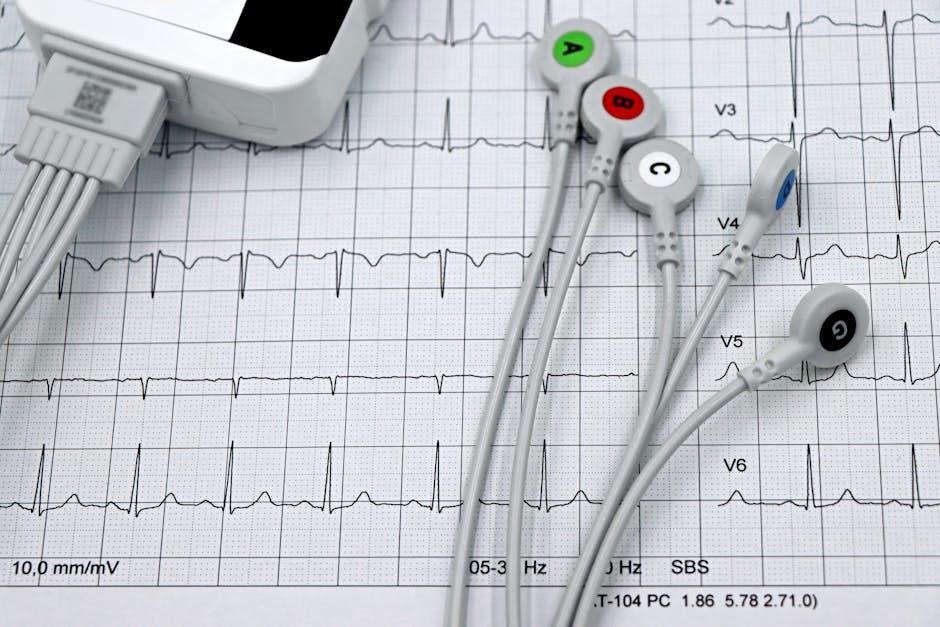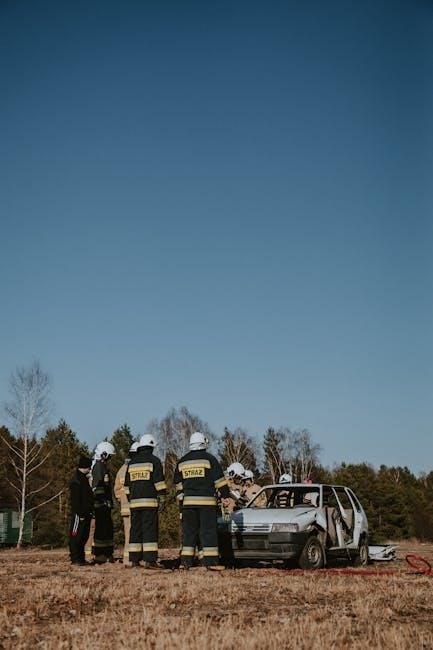Firefighter 1 practice tests are essential for preparing candidates for the certification exam. They provide realistic scenarios, multiple-choice questions, and hands-on exercises to ensure readiness for emergency situations and safety protocols.
What is Firefighter 1 Certification?
Firefighter 1 Certification is the foundational level of professional certification for firefighters, ensuring they possess essential skills and knowledge. It typically involves passing a comprehensive exam that assesses understanding of fire safety, equipment operation, emergency procedures, and communication. This certification is crucial for new firefighters, validating their ability to perform safely and effectively in real-life scenarios. Practice tests, such as those available in PDF format, are widely used to prepare for the exam, simulating its format and content to help candidates succeed.
Importance of Practice Tests
Practice tests are vital for preparing candidates for the Firefighter 1 certification exam. They simulate real exam conditions, helping candidates familiarize themselves with question formats and time limits. By tackling multiple-choice questions and case studies, individuals can identify knowledge gaps and improve their problem-solving skills. Regular practice enhances confidence and reduces exam-day anxiety. Additionally, practice tests provide insights into common mistakes, allowing candidates to refine their strategies. Accessible in PDF formats, these resources offer convenience for self-paced study. Overall, practice tests are indispensable for ensuring readiness and achieving success in the Firefighter 1 exam.

Exam Format
The Firefighter 1 exam consists of multiple-choice questions, assessing knowledge in fire safety, tools, and emergency procedures. The format includes a set number of questions within a time limit.
Number of Questions and Time Limit
A typical Firefighter 1 practice test includes 50-100 multiple-choice questions, designed to simulate the actual exam format. Candidates are usually allowed 90 minutes to complete the test, ensuring they can demonstrate their knowledge and problem-solving skills under time pressure. Some practice tests may include additional questions for thorough preparation, while others focus on core competencies. Time management is crucial, as the actual certification exam follows a similar structure. Practicing within the given time frame helps build confidence and ensures readiness for the real test. Utilizing these practice tests effectively can significantly improve performance and reduce exam-day anxiety.
Types of Questions
Firefighter 1 practice tests typically include multiple-choice questions, scenario-based problems, and case studies. Multiple-choice questions assess knowledge of firefighting procedures, safety protocols, and equipment usage. Scenario-based questions present real-life situations, requiring candidates to apply their training to resolve emergencies. Case studies evaluate critical thinking and decision-making skills. Practical exercises may involve demonstrating techniques like equipment operation or PPE usage. These question types ensure comprehensive preparation for the certification exam, covering both theoretical and practical aspects of firefighting; They also help candidates familiarize themselves with the exam format and time management. Accurate answers and detailed explanations are often provided to enhance learning and understanding of key concepts.
Passing Score Requirements
To successfully pass the Firefighter 1 certification exam, candidates typically need to achieve a minimum score of 70%. This ensures competence in critical areas like fire safety, equipment operation, and emergency procedures. Some departments may require higher scores, depending on their standards. Practice tests help candidates gauge their readiness and identify areas needing improvement. Consistent preparation ensures meeting or exceeding the required threshold for certification.

Key Topics Covered
Key topics include firefighter safety, health protocols, equipment usage, communication strategies, and emergency response procedures to ensure comprehensive preparation for real-world scenarios and certification requirements.
Firefighter Safety and Health
Firefighter safety and health are critical components of the certification process. Practice tests emphasize the importance of Personal Protective Equipment (PPE) and Self-Contained Breathing Apparatus (SCBA) usage. They also cover hazard identification, stress management, and physical fitness. Candidates learn to assess risks, prevent injuries, and maintain overall well-being. These topics ensure firefighters can operate safely in hazardous environments, protecting themselves and others. The tests simulate real-life scenarios, helping candidates apply safety protocols effectively. Understanding these principles is vital for passing the Firefighter 1 exam and performing duties confidently in the field.
Fire Tools and Equipment
Understanding fire tools and equipment is crucial for firefighter certification. Practice tests cover essential gear like ladders, hoses, nozzles, and axes. Candidates learn proper usage techniques, safety protocols, and equipment maintenance. Key tools include thermal imaging cameras for visibility in smoke-filled areas and communication devices for team coordination. Practice exams also emphasize the importance of personal protective equipment (PPE) and self-contained breathing apparatuses (SCBA). These questions ensure firefighter recruits can identify and operate equipment correctly, adhering to safety standards. Familiarity with equipment ensures efficient response during emergencies, making practice tests vital for mastering these critical skills.
Communication and Teamwork
Effective communication and teamwork are critical skills for firefighters, as they ensure safety and success in emergency situations. Firefighter 1 practice tests often include scenarios that assess these abilities, such as radio communication protocols, incident command systems, and crew coordination. Candidates are evaluated on their ability to clearly convey information, follow instructions, and work collaboratively with others. Practice tests may simulate real-life emergencies, requiring individuals to assign roles, delegate tasks, and maintain calm under pressure. These exercises help build trust and improve decision-making within teams. By mastering these skills, firefighters can enhance operational efficiency and reduce risks during missions. Strong communication and teamwork are essential for saving lives and protecting property, making them a focal point in Firefighter 1 certification preparation.

Emergency Procedures
Firefighter 1 practice tests emphasize emergency procedures, such as rescue operations and fire suppression techniques. Candidates learn to assess situations, operate equipment, and prioritize safety. Practice questions cover ladder placement, SCBA usage, and PPE deployment. Realistic scenarios, like victim rescues, test decision-making skills. Multiple-choice questions address proper protocols for hazardous environments. Case studies highlight critical actions during emergencies, ensuring preparedness for high-stress situations. These exercises refine instincts and ensure adherence to safety standards, making firefighters more effective in real-world emergencies.

Preparation Strategies
Utilize study guides, practice tests, and simulation exercises to master firefighting concepts. Regular review of safety protocols and equipment operation enhances exam readiness and real-world application skills effectively.
Using Study Guides
Study guides are a critical resource for preparing for the Firefighter 1 certification exam. They provide comprehensive overviews of key topics, such as firefighter safety, tools, and emergency procedures; Many guides include practice questions, flashcards, and detailed explanations to help candidates understand complex concepts. By using study guides, candidates can identify weaknesses and focus their study efforts effectively. Additionally, guides often include interactive elements, such as quizzes and progress tracking, to enhance learning. Leveraging study guides alongside practice tests ensures a well-rounded understanding of the material, boosting confidence and performance on exam day. They are widely available in PDF format, making them accessible for self-paced study.

Simulating Exam Conditions
Simulating exam conditions is a critical preparation strategy for the Firefighter 1 certification. By replicating the actual test environment, candidates can familiarize themselves with the time limits, question formats, and pressure of the real exam. Practice tests should be taken in a quiet, distraction-free setting to mirror exam conditions. Setting a timer for the allocated time helps build time management skills and reduces anxiety. Additionally, using the same types of questions found on the actual exam, such as multiple-choice and scenario-based queries, ensures candidates are prepared for the content and structure. This method also allows individuals to identify weak areas and refine their test-taking strategies before the actual examination. Regular simulation builds confidence and improves performance under pressure.
Understanding Answer Patterns
Analyzing answer patterns in Firefighter 1 practice tests helps candidates identify common question structures and recurring themes. By recognizing these patterns, individuals can better anticipate the exam’s focus areas, such as fire safety protocols or equipment operations. For instance, many questions emphasize situational judgment, requiring candidates to apply knowledge of emergency procedures. Understanding these patterns enables test-takers to allocate study time more effectively and approach questions with confidence. Additionally, recognizing answer patterns can reveal often-tested topics, such as communication strategies or tool usage, allowing for targeted preparation. This strategic insight is crucial for maximizing scores and ensuring readiness for real-world firefighting scenarios.

Practice Questions
Firefighter 1 practice tests include multiple-choice questions and real-life scenarios to assess knowledge and decision-making. These questions cover fire safety, tools, and emergency procedures, ensuring exam readiness and practical skill application.
Sample Multiple-Choice Questions
Sample multiple-choice questions are a cornerstone of Firefighter 1 practice tests, mirroring the actual exam format. They cover critical topics such as ladder safety, equipment operation, and emergency procedures. For example:
Question 1: If a 35-foot ladder is needed to reach a 24-foot height, where should the base be placed?
- A. 7 feet away
- B. 10 feet away
- C. 12 feet away
- D. 15 feet away

Correct Answer: C. 12 feet away
Question 2: What is the primary purpose of an SCBA?
- A. To communicate with team members
- B. To provide a reliable air supply
- C. To carry tools
- D. To extinguish fires
Correct Answer: B. To provide a reliable air supply
These questions help candidates assess their knowledge and identify areas for improvement, ensuring they are well-prepared for the certification exam.
Case Studies and Scenarios
Case studies and scenarios in Firefighter 1 practice tests simulate real-life emergency situations, allowing candidates to apply their knowledge and skills. These exercises often involve complex incidents, such as rescue operations, hazardous material spills, or structural fires, requiring critical thinking and decision-making. By analyzing these scenarios, candidates can improve their ability to prioritize actions, communicate effectively, and operate equipment under pressure. Many practice tests include detailed narratives and questions that mirror actual incidents, helping firefighters understand proper protocols and safety measures. These realistic simulations are invaluable for building confidence and ensuring preparedness for the challenges of the job.
Answer Analysis and Feedback
Answer analysis and feedback are crucial components of Firefighter 1 practice tests, enabling candidates to understand their performance. Detailed explanations for each question help identify strengths and weaknesses. Feedback highlights correct answers, provides rationales, and explains common mistakes. This feature ensures learners grasp key concepts and improve problem-solving skills. Many practice tests include verified answers and case studies to enhance comprehension. By reviewing feedback, candidates can focus on areas needing improvement, ensuring better preparedness for the actual exam. This iterative learning process builds confidence and competence, making practice tests an indispensable tool for Firefighter 1 certification success.

Test-Taking Tips
Manage your time wisely, answer easy questions first, and avoid changing answers. Stay calm, read questions carefully, and eliminate incorrect options to increase scoring chances.
Time Management Techniques
Effective time management is crucial for success on the Firefighter 1 certification exam. Allocate a specific time for each question to avoid spending too long on a single one. For example, allow 1-2 minutes per multiple-choice question and 5-10 minutes for scenario-based questions. Prioritize answering easier questions first to secure points before tackling more challenging ones. Use the remaining time to review unanswered questions and make educated guesses. Practicing under timed conditions during preparation helps build speed and accuracy. Additionally, avoid wasting time on questions that are unclear—mark them and return later. This strategy ensures efficient use of the exam duration and minimizes stress. Regular practice with timed tests enhances overall performance and confidence. Proper time management is key to achieving a high score and becoming a certified firefighter.
Common Mistakes to Avoid
When preparing for the Firefighter 1 certification exam, candidates often make avoidable errors. Rushing through practice questions without understanding concepts is a common mistake. Neglecting to review incorrect answers can hinder improvement. Overcomplicating simple questions leads to confusion; Poor time management during practice tests results in unanswered questions. Additionally, failing to familiarize oneself with the exam format and question types increases anxiety. It’s crucial to learn from mistakes and refine test-taking strategies to ensure success. Consistent practice and careful analysis of errors are key to achieving a high score.
Maintaining Composure
Maintaining composure during the Firefighter 1 certification exam is crucial for optimal performance. Stress and anxiety can impede decision-making, so candidates must employ relaxation techniques. Deep breathing exercises can help calm the mind, while positive visualization can build confidence. Practicing under timed conditions, as in the sample questions, allows candidates to familiarize themselves with the exam’s pressure. Additionally, breaking down complex scenarios into manageable steps can reduce overwhelm. Staying focused on one question at a time prevents distractions and ensures thorough attention to detail. Retaining a steady mindset enables candidates to approach each problem methodically, even in high-stakes situations. Consistent practice, as seen in the firefighter 1 practice test PDF, reinforces mental resilience and readiness for real-world challenges. Composure is key to demonstrating skills effectively during the exam.

Additional Resources
Find recommended PDF guides, online courses, and community forums for comprehensive preparation. These resources offer in-depth study materials, interactive tutorials, and peer support to aid your success.
Recommended PDF Materials
Several high-quality Firefighter 1 practice test PDFs are available online to aid in exam preparation. One popular resource is the “Firefighter 1 Practice Test 2024”, which includes 50 realistic multiple-choice questions and detailed answer explanations. Another recommended material is the “Firefighter I Written Exam Sample”, offering scenario-based questions to simulate actual test conditions. Additionally, “Firefighter 1 Study Guide with Practice Questions” provides comprehensive coverage of key topics, such as fire tools, safety protocols, and emergency procedures. These PDFs can be downloaded from platforms like Docsity or official firefighter training websites. They are designed to help candidates familiarize themselves with the exam format and improve their problem-solving skills. Using these resources ensures a well-rounded and effective study approach.
Online Courses and Tutorials
Online courses and tutorials are invaluable resources for preparing for the Firefighter 1 certification exam. Platforms like Docsity and Performance Training Systems offer comprehensive materials, including practice tests, video tutorials, and interactive modules. These courses cover essential topics such as fire safety, equipment operation, and emergency procedures. Many programs are designed to simulate real-world scenarios, helping candidates build practical skills. Some courses also provide downloadable PDF guides and flashcards for offline study. The flexibility of online learning allows candidates to study at their own pace, ensuring they are well-prepared for the exam. Additionally, these resources often include feedback mechanisms to help identify areas for improvement. By leveraging these tools, candidates can gain a deeper understanding of the material and enhance their readiness for the Firefighter 1 practice test.
Community Forums and Groups
Community forums and groups are invaluable resources for candidates preparing for the Firefighter 1 certification. Online platforms like Reddit, firefighter forums, and Facebook groups provide spaces to discuss strategies, share study materials, and gain insights from experienced firefighters. Many forums offer access to practice tests, study guides, and real-life scenarios to help candidates better understand the exam format. Active participation in these communities allows candidates to connect with peers, address doubts, and stay motivated. Additionally, some groups host live Q&A sessions with certified instructors, offering personalized feedback and tips. Engaging with these communities complements traditional study methods and ensures candidates stay updated on the latest exam trends and resources. Actively contributing to these forums can significantly enhance one’s preparation journey.
Firefighter 1 practice tests are invaluable tools for candidates aiming to excel in their certification exams. These resources provide realistic scenarios, multiple-choice questions, and hands-on exercises, ensuring thorough preparation for emergency situations and safety protocols. By utilizing practice tests, candidates can identify weak areas, improve time management, and build confidence. PDF materials, online courses, and community forums further enhance learning. Consistent practice and review of test patterns help candidates understand the exam format and avoid common mistakes. Ultimately, dedication and strategic preparation are key to achieving success in the Firefighter 1 certification; These resources empower aspiring firefighters to perform at their best, ensuring they are ready to serve their communities effectively and safely;
